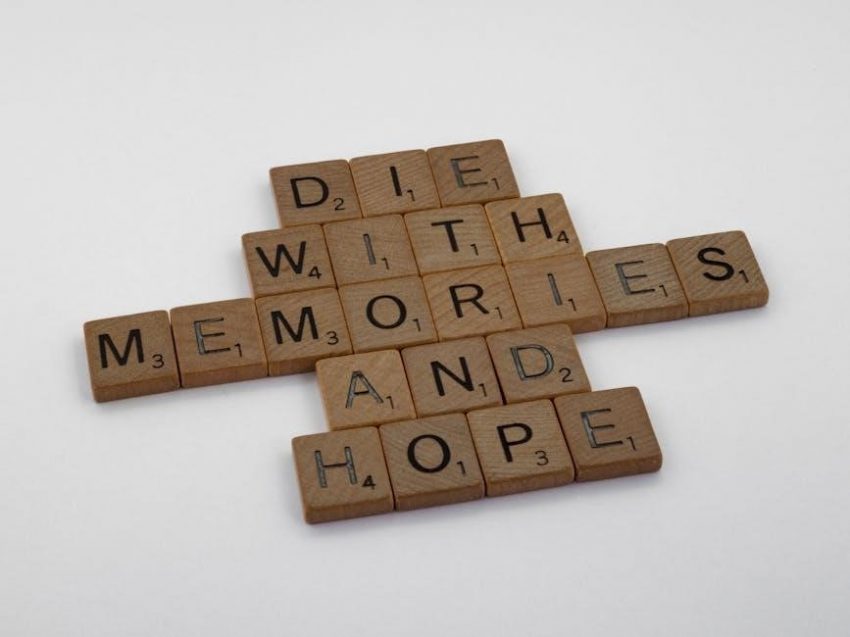Discover the timeless appeal of crossword puzzles as a classic intellectual activity, offering mental stimulation and cognitive benefits for enthusiasts of all ages and skill levels.
1.1. Brief History of Crossword Puzzles
The crossword puzzle, invented by Arthur Wynne in 1923, first appeared in the New York World as a “word-cross” puzzle. Initially called a “word-square,” it gained popularity in the 1920s, becoming a cultural phenomenon. The name evolved to “crossword puzzle” by 1924, reflecting its grid structure. Over the decades, crosswords became a staple in newspapers worldwide, with evolving designs and themes. This intellectual activity has endured, offering mental stimulation and entertainment to millions, adapting to modern technologies while retaining its classic charm.
1.2. Evolution of Crossword Puzzle Design
From its inception, crossword puzzle design has evolved significantly, transitioning from simple word squares to sophisticated themes and grid patterns. Early crosswords featured basic square grids, while modern designs incorporate symmetry, black square placement, and themed puzzles. The introduction of themed crosswords in the mid-20th century added layers of complexity and engagement. Today, constructors use computer software to craft intricate puzzles, ensuring balance and challenge. This evolution reflects changing solver preferences and the demand for mentally stimulating entertainment, adapting crossword puzzles to remain relevant across generations and skill levels.
1.3. Importance of Crossword Puzzles in Cognitive Development
Crossword puzzles play a significant role in cognitive development by enhancing memory, vocabulary, and problem-solving skills. They stimulate mental activity, fostering critical thinking and logical reasoning. Regular engagement improves concentration and focus, while the satisfaction of completing a puzzle boosts confidence and mental well-being. Crosswords also delay cognitive decline in older adults by keeping the brain active and sharp. This engaging activity is widely recognized as a valuable tool for lifelong learning and mental health, making it a popular choice for individuals seeking intellectual challenges and personal growth.

Understanding the Role of a Manual Reader
A manual reader skillfully solves crossword puzzles by deciphering clues, utilizing word roots, and applying logical strategies, ensuring accuracy and completion without relying on automated tools.
2.1. Definition and Responsibilities of a Manual Reader
A manual reader is an individual skilled in solving crossword puzzles without automated tools. Their responsibilities include deciphering clues, identifying patterns, and systematically filling the grid. They rely on vocabulary, logic, and critical thinking to complete puzzles accurately. Proficient readers use techniques like word roots and overlaps to navigate challenges. Their role emphasizes mental engagement and problem-solving, making them adept at handling complex crosswords. This method enhances cognitive skills and provides a sense of accomplishment upon completion, fostering continuous improvement in puzzle-solving abilities.
2.2. Skills Required for Effective Crossword Puzzle Solving
Effective crossword puzzle solving demands a strong vocabulary, analytical thinking, and pattern recognition. Solvers must decipher clues, both literal and metaphorical, often requiring lateral thinking. Attention to detail is crucial to avoid errors, while time management ensures efficient progress. Adaptability is key, as clues can be ambiguous or pun-based. Proficiency in identifying word roots and prefixes enhances problem-solving. Combining these skills allows manual readers to tackle puzzles systematically, ensuring accuracy and completion. These abilities not only improve cognitive function but also foster a sense of accomplishment with each solved puzzle.
2.3. Tools and Resources for Manual Crossword Puzzle Readers
Manual crossword puzzle readers rely on dictionaries, thesauruses, and crossword puzzle books for reference. Online resources like crossword solvers and forums provide additional support. Flashcards can aid vocabulary building, while pens and erasable markers help prevent errors. Timers and strategy guides enhance efficiency and accuracy. Highlighters and grid maps assist in tracking progress. Crossword construction books and apps offer insights into puzzle design. These tools collectively empower solvers to tackle challenges with confidence and precision, ensuring a rewarding experience. They serve as indispensable aids for both beginners and seasoned enthusiasts alike.
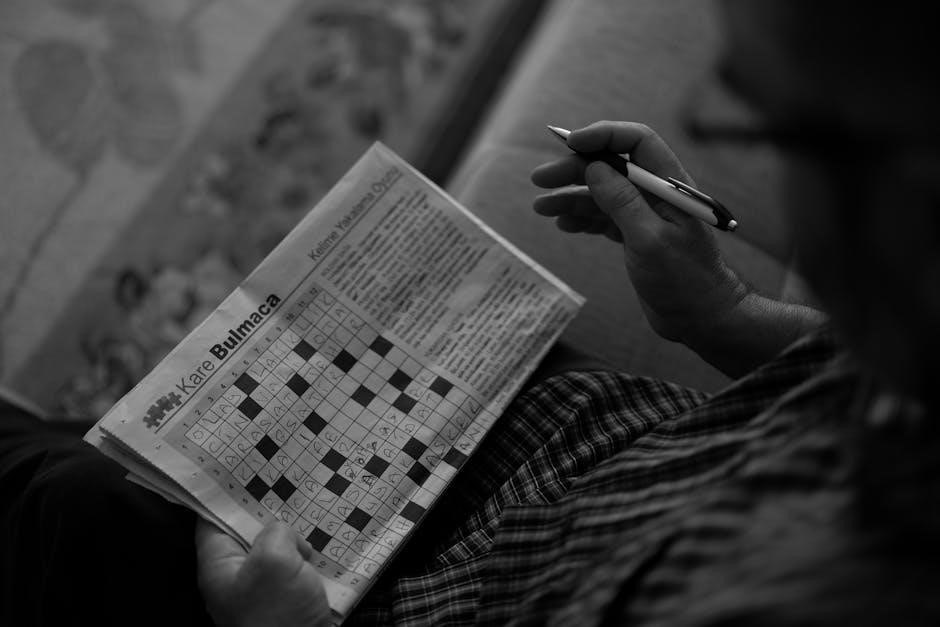
The Process of Solving Crossword Puzzles Manually
Manual crossword solving involves starting with simple clues, analyzing patterns, and using word overlaps to systematically fill the grid and complete the puzzle accurately.
3.1. Strategies for Starting a Crossword Puzzle
Begin by tackling short answers and simple clues, as these provide quick wins and reveal letters that can unlock longer words. Look for common letters like E, T, or A, which frequently appear in crosswords. Identify word overlaps, where the ending of one word matches the beginning of another, to fill the grid systematically. Start with clues that contain numbers or proper nouns, as these often have unique solutions. Avoid guessing blindly; instead, use word roots or prefixes to deduce answers. Reading clues carefully and methodically ensures progress, while building confidence to tackle harder clues.
3.2. Identifying Key Clues and Patterns
Identifying key clues and patterns is essential for solving crossword puzzles manually. Start by pinpointing clues with numbers or unique identifiers, as these often provide clear starting points. Look for common word endings like -ED or -ING, as well as recurring letters such as E, T, and A. Patterns like anagrams or reversals can also be identified by closely examining clue wording. Pay attention to symmetric designs in the grid, as this can reveal overlapping words. Recognizing these patterns helps in systematically filling the grid and connecting seemingly unrelated clues, making the solving process more efficient and enjoyable.
3.3. Using Word Overlaps to Fill in the Grid
Word overlaps are a critical strategy in manually solving crossword puzzles, as they help connect intersecting words. By identifying shared letters at grid intersections, solvers can deduce unknown words more efficiently. For example, if a horizontal word ends with “E” and a vertical word starts with “E,” this overlap can reveal the starting letter of the vertical word. This technique is particularly useful when clues are ambiguous or when filling in gaps between known words. Systematically applying word overlaps allows solvers to build momentum and complete the grid with greater accuracy and confidence.
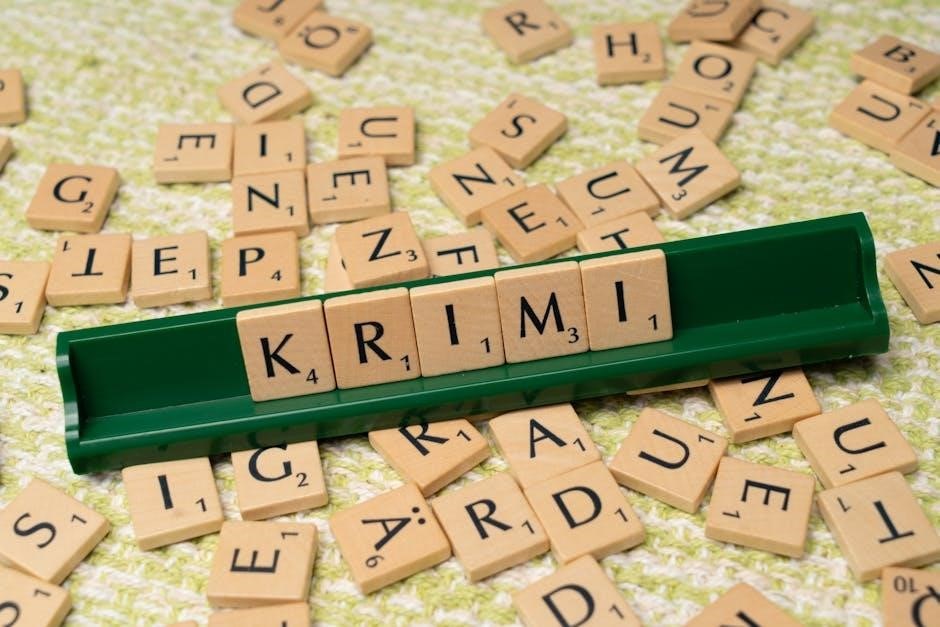
Advanced Techniques for Crossword Puzzle Construction
Mastering crossword creation involves designing grids, crafting clever clues, and ensuring symmetry. Advanced constructors use unique themes, word overlaps, and balanced difficulty to engage solvers effectively.
4.1. Designing Crossword Grids
Designing crossword grids requires precision and creativity. Constructors ensure symmetry by mirroring black squares across the grid’s center. A well-balanced grid contains a mix of short and long answers, avoiding excessive black squares. Themes are placed strategically to enhance solver engagement. Grid patterns often follow standard sizes, such as 15×15 for daily puzzles. Constructors use specialized software to streamline the process, ensuring that the grid adheres to both visual and functional standards. The grid’s structure is crucial for a seamless and enjoyable solving experience, making it a cornerstone of crossword puzzle construction.
4.2. Creating Engaging and Challenging Clues
Crafting crossword clues requires a balance of clarity and cleverness. Constructors often use wordplay, puns, and clever twists to make clues both challenging and fun. Clues should be precise yet misleading enough to avoid being too straightforward. Different clue types, such as definitions, anagrams, and puns, add variety and keep solvers engaged. Theme clues are particularly important, as they tie the puzzle together and provide a satisfying reveal. Constructors also ensure clues are fair and solvable, avoiding overly obscure references. The art of clue-writing is central to a crossword’s appeal and enjoyment.
4.3. Ensuring Symmetry and Balance in the Grid
Symmetry and balance are crucial in crossword grids to ensure a polished and visually appealing design. Most crosswords are symmetrical, meaning the pattern mirrors along a vertical, horizontal, or diagonal axis. Constructors use this symmetry to maintain fairness and aesthetics. Balance involves distributing black squares and word paths evenly, avoiding cluttered or sparse areas. Proper grid design enhances solver experience, making puzzles more enjoyable and challenging. Constructors often refine layouts to achieve harmony, ensuring both functionality and artistic appeal.
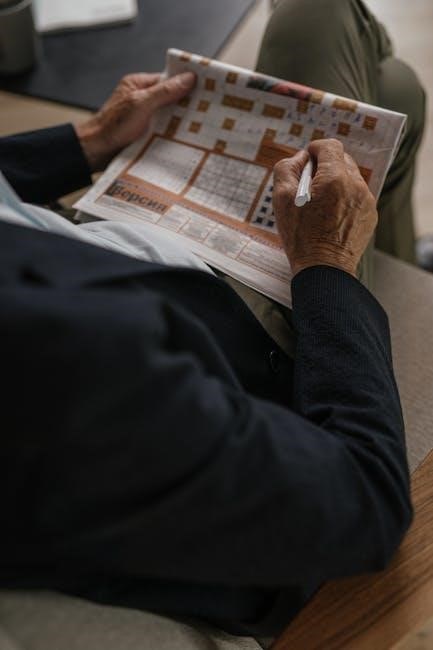
The Role of Technology in Crossword Puzzles
Technology has revolutionized crossword puzzles by offering automated solvers, digital grids, and advanced tools for constructors, enhancing both creation and solving experiences with precision and speed.
5.1. Automated Crossword Solvers
Automated crossword solvers leverage advanced algorithms to rapidly solve puzzles by exploring word permutations and comparing them against extensive dictionaries. These tools enable quick resolution of complex clues, often outpacing human solvers. By utilizing pattern recognition and linguistic databases, they can auto-fill grids with remarkable accuracy. However, while technology enhances efficiency, it lacks the intuition and creative thinking that manual solvers bring to the table, making it a complementary rather than replacement tool for enthusiasts seeking both challenge and enjoyment in crossword puzzle solving experiences.
5.2. Comparison of Manual vs. Automated Solving
Manual crossword solving emphasizes cognitive engagement, problem-solving, and personal satisfaction, enhancing mental agility and vocabulary. It requires strategic thinking and creativity, offering a fulfilling experience. Automated solvers, however, rely on algorithms and databases for rapid solutions, sacrificing the intellectual challenge. While automation excels in speed and accuracy, manual solving fosters deeper cognitive benefits and enjoyment, making it a preferred choice for those seeking intellectual stimulation and personal achievement in crossword puzzle activities.
5.3. The Future of Crossword Puzzle Solving
The future of crossword puzzle solving lies in a blend of tradition and technology. While manual solving remains popular for its cognitive benefits, automated tools will enhance accessibility and speed. Hybrid models, combining manual and automated approaches, may emerge, offering dynamic solving experiences. Crosswords will likely integrate with educational platforms, teaching languages and subjects. Virtual reality and augmented reality could redefine how puzzles are solved, making them more immersive. The evolution of crossword puzzles will ensure their relevance in a rapidly changing world, appealing to both traditionalists and tech-savvy solvers.
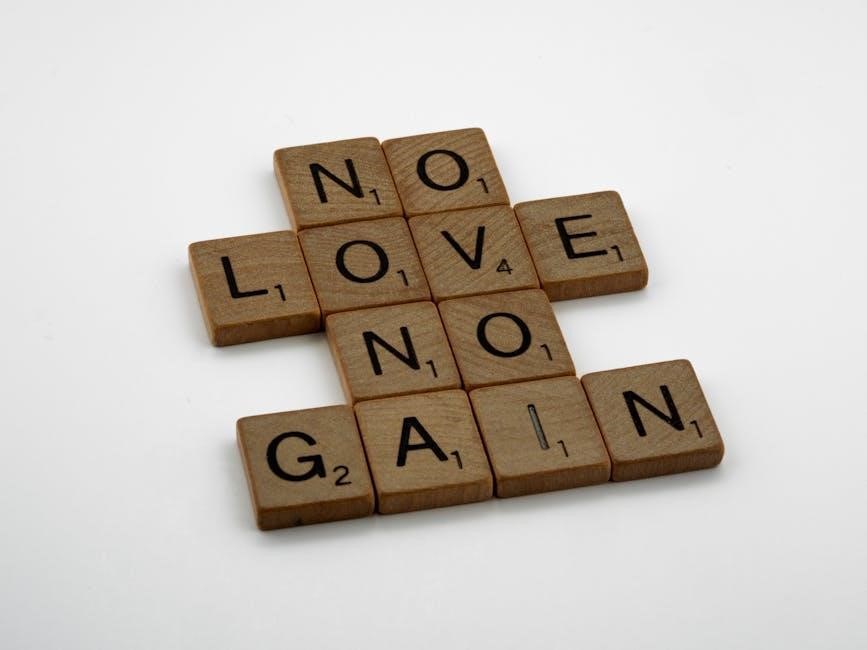
The Psychology of Crossword Puzzle Solving
Crossword puzzles enhance cognitive skills, improve memory, and boost problem-solving abilities. They provide a sense of accomplishment, fostering mental stimulation and relaxation, making them a popular mental exercise.
6.1. Cognitive Benefits of Regular Crossword Solving
Engaging in regular crossword puzzle solving offers significant cognitive benefits. It enhances memory retention, improves vocabulary, and boosts problem-solving skills. Crosswords stimulate the brain by challenging it to recall words, patterns, and connections, which can delay cognitive decline. They also improve concentration and mental agility, fostering a sharper mind. Additionally, crosswords promote logical thinking and patience, making them an excellent mental exercise for individuals of all ages. Regular solving can lead to improved academic and professional performance, as it sharpens critical thinking and enhances linguistic abilities.
- Improves memory and recall
- Enhances vocabulary and language skills
- Boosts problem-solving and critical thinking
- Delays cognitive decline
- Sharpens concentration and focus
6;2. Problem-Solving Strategies in Crosswords
Solving crosswords manually requires a strategic approach to unravel clues effectively. Start by identifying easy clues to build momentum and fill in obvious answers first. Use word overlaps to deduce missing letters, and eliminate unlikely options by process of elimination. Pay attention to clue patterns, such as puns or anagrams, which often hint at creative wordplay. Break down complex clues into smaller parts, and leverage knowledge of prefixes, suffixes, and common phrases. Staying patient and methodical ensures a more enjoyable and successful solving experience.
- Begin with straightforward clues
- Utilize word overlaps and letter patterns
- Eliminate impossible answers
- Analyze clue types and wordplay
- Maintain a calm and systematic approach
6.3. The Satisfaction of Completing a Crossword Puzzle
Completing a crossword puzzle manually offers a profound sense of accomplishment and mental fulfillment. The process challenges the brain, fostering problem-solving skills and reinforcing memory. Each filled-in answer builds confidence, while overcoming difficult clues provides a thrill of achievement. The final completed grid symbolizes perseverance and intellectual growth, leaving a lasting feeling of satisfaction and pride. This rewarding experience makes crossword puzzles a beloved activity for many, combining relaxation with cognitive stimulation.
- Builds confidence and mental agility
- Encourages persistence and patience
- Provides a sense of intellectual achievement
- Enhances problem-solving abilities
- Offers a calming, rewarding experience
Crossword Puzzle Communities and Events
Crossword puzzle communities and events foster connections among enthusiasts, creating a shared passion for wordplay. These gatherings celebrate intellectual challenges and camaraderie through competitions and collaborative solving.
- Annual conventions and tournaments
- Online forums and discussion groups
- Charity events promoting literacy
- Workshops for constructors and solvers
7.1. Popular Crossword Puzzle Competitions
Crossword puzzle competitions attract enthusiasts worldwide, showcasing skill and strategy. The American Crossword Puzzle Tournament, held annually in New York, is one of the most prestigious events, drawing top solvers since 1978. Similarly, the UK Times Crossword Championship challenges participants with its rigorous, high-level clues. These events often feature cash prizes and recognition within the crossword community. Competitors must solve puzzles quickly and accurately under time pressure, demonstrating their mastery of wordplay and pattern recognition. Such competitions foster camaraderie and celebrate the intellectual thrill of crossword solving.
- American Crossword Puzzle Tournament
- UK Times Crossword Championship
- World Crossword Championship
7.2. Online Communities for Crossword Enthusiasts
Online communities have become vibrant hubs for crossword enthusiasts, fostering connections and shared passion; Platforms like Reddit’s r/CrosswordPuzzles and specialized crossword forums offer spaces to discuss strategies, share tips, and collaborate on challenging puzzles. These communities often host virtual events, puzzle exchanges, and competitive solving sessions. They also provide resources, such as databases of past crosswords and solving guides, catering to both beginners and seasoned solvers. Engaging with these groups enhances problem-solving skills and builds camaraderie among crossword lovers worldwide.
- Reddit’s r/CrosswordPuzzles
- Specialized crossword forums
- Virtual puzzle-solving events
7.3. The Role of Crossword Puzzle Clubs
Crossword puzzle clubs play a vital role in fostering community and passion for puzzle-solving. These clubs provide a platform for enthusiasts to gather, share techniques, and solve crosswords collectively. Many clubs organize regular meetups, tournaments, and workshops, catering to both novice and experienced solvers. They also often publish their own puzzles or curate collections of challenging crosswords. Membership in such clubs enhances problem-solving skills, encourages teamwork, and creates a sense of belonging among participants. Clubs like the Crossword Puzzle Club of America exemplify this role, offering resources and events that celebrate the joy of crosswords.
- Regular meetups and tournaments
- Workshops and skill improvement
- Community-building through shared passion

The Art of Crossword Puzzle Construction
Crossword puzzle construction combines creativity with technical skill, requiring careful grid design, symmetry, and theme development to create engaging, solvable, and intellectually stimulating challenges for enthusiasts.
8.1. Theme Development in Crosswords
Theme development is the heartbeat of crossword construction, where creators craft unique, engaging themes that tie clues and answers together. A strong theme enhances solvability and enjoyment, making crosswords more than just a grid of words. Themes often revolve around a central idea, such as holidays, literature, or pop culture, and require careful planning to ensure consistency. Constructors use techniques like wordplay, puns, and clever misdirection to make themes memorable. This artistic process balances creativity with technical skill, ensuring the puzzle is both fun and challenging for solvers.
8.2. Creating Unique and Memorable Crossword Themes
Creating unique and memorable crossword themes involves blending creativity with originality. Constructors often use wordplay, puns, or clever misdirection to craft themes that stand out. Themes can revolve around movies, literature, sports, or cultural trends, making puzzles more relatable and engaging. The key is to balance uniqueness with solvability, ensuring the theme is both challenging and rewarding. A well-designed theme leaves solvers with a sense of accomplishment and delight, making the puzzle memorable long after completion. This artistry keeps crosswords fresh and exciting for enthusiasts.
8.3. The Importance of Grid Design
Grid design is crucial for a crossword puzzle’s functionality and appeal. A well-structured grid ensures smooth interaction between clues, avoiding overlaps that confuse solvers. Symmetry and balance are key, making puzzles visually pleasing and mentally stimulating. The placement of black squares and themed entries impacts the puzzle’s difficulty and flow. Effective grid design enhances the solver’s experience, ensuring that the challenge is enjoyable and solvable. It also allows for creative freedom in theme development, making each puzzle unique and engaging for manual readers seeking intellectual stimulation. Proper design elevates the overall quality of the crossword.
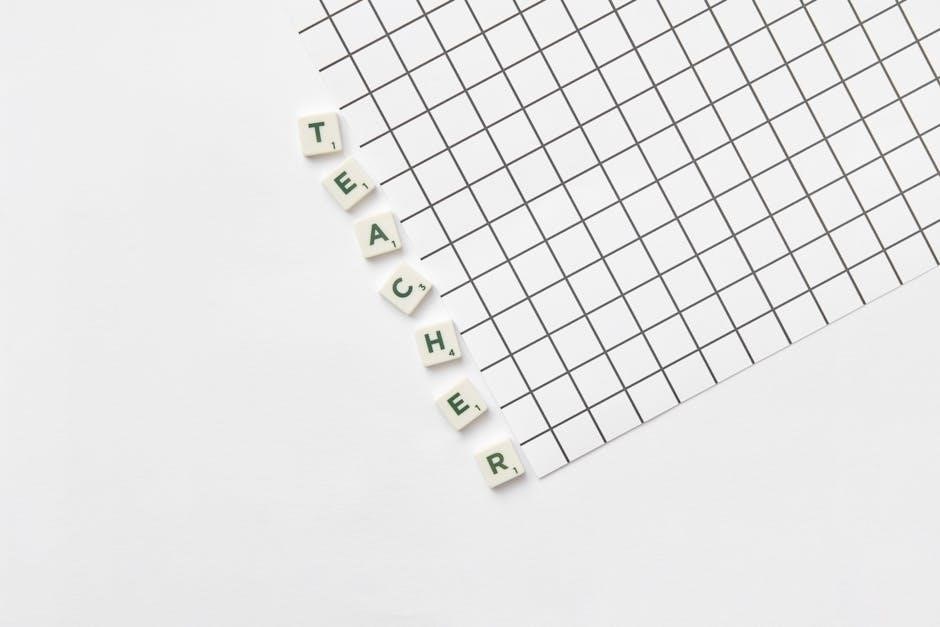
Crossword Puzzle Solving Tips and Tricks
Master crossword puzzles by starting with easy clues, using word overlaps, and eliminating wrong answers. Strategy, vocabulary, and confidence are key to solving grids efficiently and enjoyably.
9.1. Breaking Down Complex Clues
When faced with intricate crossword clues, dissect them into manageable parts. Identify the clue type—definition, anagram, or pun—and look for keywords. Use word roots, prefixes, and suffixes to decode meanings. For example, “flower that’s also a girl’s name” could be “Lily.” Eliminate impossible answers and consider common crossword conventions. Practice regularly to sharpen your pattern recognition and linguistic intuition, enhancing your ability to tackle even the most challenging clues with confidence and efficiency.
9.2. Using Word Roots and Prefixes
Mastering word roots and prefixes is a powerful strategy for crossword solvers. Many words share common roots or prefixes, such as “tele-” (distance) or “-logy” (study). Recognizing these patterns can help decode unfamiliar terms. For example, “telephone” combines “tele-” (far) and “phone” (voice). Similarly, “biology” merges “bio-” (life) and “-logy” (science). By identifying these elements, solvers can deduce meanings and fill in answers more efficiently. Practice identifying roots and prefixes to enhance your crossword-solving skills and expand your vocabulary effectively.
9.3. Managing Time Effectively While Solving
Effective time management is crucial for solving crossword puzzles efficiently. Start by tackling easier clues first, such as short answers and common words, to build momentum. Allocate specific time intervals to each section, focusing on high-impact areas. Avoid getting stuck on a single clue; move on and return later with a fresh perspective. Use a systematic approach, such as solving across and then down, to maximize progress. Regular practice helps improve speed and accuracy, allowing solvers to enjoy the process without feeling rushed. Time management enhances both productivity and enjoyment.

The Impact of Crossword Puzzles on Education
Crossword puzzles serve as engaging tools for enhancing vocabulary, improving spelling, and fostering critical thinking skills in educational settings, making learning enjoyable and interactive for students.
10.1. Crosswords as a Learning Tool
Crossword puzzles are versatile learning tools that cater to diverse age groups and skill levels, enhancing vocabulary, spelling, and critical thinking. By engaging students in problem-solving, they foster active learning and retention. Crosswords introduce new words and concepts, making them ideal for language acquisition and subject-specific knowledge. They encourage independent study and teamwork, promoting collaboration in educational settings. Their interactive nature makes complex topics more accessible and enjoyable, aligning with curriculum goals and fostering a deeper understanding of various subjects through structured, challenging exercises.
10.2. Enhancing Vocabulary Through Crosswords
Crossword puzzles are a powerful tool for expanding vocabulary, introducing players to new words and their meanings. The structured format challenges individuals to think critically, connecting clues to definitions. Regular engagement improves spelling, retention, and linguistic comprehension. Crosswords cater to all skill levels, making them accessible for learners at any stage. The combination of entertainment and education fosters a love for language learning, while the gradual exposure to complex words builds confidence and enhances overall communication skills, making crosswords a fun and effective way to enrich vocabulary.
10.3. Using Crosswords in Classroom Settings
Crossword puzzles are a versatile educational tool, fostering active learning and engagement in classroom environments. Educators can design puzzles tailored to specific subjects, such as history, science, or literature, to reinforce lesson content. Students benefit from improved retention and vocabulary expansion, while developing critical thinking skills. Crosswords also cater to diverse learning styles, encouraging teamwork when solved collaboratively. Teachers can customize puzzles to align with curriculum goals, making them an effective and interactive resource for enhancing student understanding and participation in various academic areas.
Crossword Puzzle Solving for Beginners
Beginners can start with simple crosswords, focusing on short answers and easy clues to build confidence and develop essential solving strategies and techniques gradually.
11.1. Starting with Simple Crosswords
Beginners should start with simple crosswords featuring straightforward clues and smaller grids. Focus on short answers and common words to build confidence. Use word roots and prefixes to decode clues. Avoid complex themes or tricky patterns initially. Start with Monday-level puzzles, gradually progressing to harder ones. Pay attention to overlapping words, as they can help fill in the grid. Practice regularly to enhance vocabulary and problem-solving skills. This approach ensures a smooth transition from basic to more challenging crosswords, fostering enjoyment and skill development.
11.2. Building Confidence in Solving
Building confidence in crossword solving involves celebrating small victories and embracing progress. Start by acknowledging each correct answer, no matter how simple. Understand that clue types vary, and familiarity with them grows over time. Stay patient with challenging clues, as persistence is key. Regular practice helps develop vocabulary and pattern recognition, gradually boosting confidence. Don’t hesitate to use tools like dictionaries or hint guides when needed. Over time, solvers become more adept at decoding clues and filling grids, fostering a sense of accomplishment and enjoyment in the process.
11.3. Common Mistakes to Avoid
Common mistakes to avoid when solving crossword puzzles include rushing through clues without careful reading, guessing too quickly, and neglecting word overlaps. Beginners often overlook pattern recognition and assume clues are too vague. Another pitfall is ignoring smaller words, which are often easier to fill in first. Time management is crucial; spending too long on one clue can hinder progress. Additionally, avoid entering answers without double-checking for accuracy, as this can lead to errors in interconnected words. Lastly, don’t skip reviewing completed sections to ensure consistency and correctness.

The Role of Crossword Puzzles in Cognitive Therapy
Crossword puzzles play a significant role in cognitive therapy by enhancing memory, improving mental clarity, and providing a therapeutic outlet for rehabilitation and mental stimulation.
12.1. Crosswords and Memory Improvement
Crossword puzzles actively engage the mind, enhancing memory recall by challenging individuals to remember words, patterns, and associations. Regular solving strengthens both short-term and long-term memory, fostering cognitive function. The structured nature of crosswords makes them an effective therapeutic tool for rehabilitation, aiding those with memory loss or cognitive impairments. By reinforcing neural pathways, crosswords help improve retention and retrieval of information, making them a valuable asset in cognitive therapy and mental stimulation.
12.2. Using Crosswords for Mental Stimulation
Crossword puzzles provide dynamic mental stimulation, challenging individuals to engage their reasoning, vocabulary, and problem-solving skills. Solving crosswords exercises the brain, fostering critical thinking and linguistic ability. The process of deciphering clues and fitting words into the grid enhances cognitive flexibility and mental agility. Regularly tackling crosswords can improve focus, concentration, and overall mental acuity, making them an excellent tool for maintaining sharp cognitive function and promoting intellectual engagement. They offer a rewarding way to keep the mind active and challenged, regardless of age or skill level.
12.3. Crosswords as a Tool for Rehabilitation
Crossword puzzles are increasingly used in rehabilitation settings to aid cognitive recovery and mental well-being. They help individuals regain memory, focus, and language skills, particularly after brain injuries or illnesses. The structured nature of crosswords provides a calming, goal-oriented activity that fosters mental clarity and confidence. Therapists often incorporate crosswords into treatment plans to stimulate neural pathways and enhance problem-solving abilities. Their accessibility and engaging format make them a valuable tool for patients at various stages of recovery, promoting both intellectual and emotional healing in a supportive environment.

